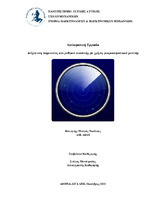| dc.contributor.advisor | Mitilineos, Stelios A. | |
| dc.contributor.author | Παππάς, Νικόλαος | |
| dc.date.accessioned | 2021-11-08T12:43:47Z | |
| dc.date.available | 2021-11-08T12:43:47Z | |
| dc.date.issued | 2021-10-18 | |
| dc.identifier.uri | https://polynoe.lib.uniwa.gr/xmlui/handle/11400/1500 | |
| dc.identifier.uri | http://dx.doi.org/10.26265/polynoe-1351 | |
| dc.description.abstract | Το βασικό αντικείμενο της εν λόγω διπλωματικής εργασίας είναι η ανίχνευση ανθρώπων σε εσωτερικό χώρο με την βοήθεια ενός UWB radar και του ModuleConnector. Αρχικά, παρουσιάζονται οι τρόποι με τους οποίους μπορεί να αξιοποιηθεί το radar της Xethru ενώ ταυτόχρονα περιγράφονται αναλυτικά οι διαδικασίες καθώς και τα αποτελέσματα από τις παραπάνω εφαρμογές.
Στην συνέχεια, αναλύονται τα πειράματα και οι διαδικασίες που πραγματοποιούνται και μελετώνται για την καλύτερη κατανόηση της χρήσης ενός UWB radar. Με τα πειράματα αυτά θα είναι σε θέση κάποιος να καταλάβει την ουσιαστική λειτουργία των κριτηρίων που δημιουργούνται με την βοήθεια του Matlab. Αφού κατανοηθούν οι βασικές λειτουργίες του radar καθώς και τα κριτήρια που χρησιμοποιούνται για την αξιολόγηση της ύπαρξης ή μη ανθρώπου στο χώρο, προχωράμε στο τελευταίο στάδιο που αφορά ένα μεγάλο χώρο ενός σπιτιού και πως το radar αλληλεπιδρά με περισσότερα αντικείμενα. Τέλος, θα εξεταστεί το ραντάρ κάτω από πραγματικές συνθήκες που αφορούν την εκπομπή του σήματος πίσω από ένα υλικό αντικείμενο, αν τα αποτελέσματα που λαμβάνει είναι ορθά και κατά πόσο είναι εφικτό να θεωρηθούν αξιόλογα για ανάλυση. | el |
| dc.format.extent | 71 | el |
| dc.language.iso | el | el |
| dc.publisher | Πανεπιστήμιο Δυτικής Αττικής | el |
| dc.rights | Αναφορά Δημιουργού - Μη Εμπορική Χρήση - Παρόμοια Διανομή 4.0 Διεθνές | * |
| dc.rights | Attribution-NonCommercial-NoDerivatives 4.0 Διεθνές | * |
| dc.rights | Attribution-NonCommercial-NoDerivatives 4.0 Διεθνές | * |
| dc.rights | Attribution-NonCommercial-NoDerivatives 4.0 Διεθνές | * |
| dc.rights | Attribution-NonCommercial-NoDerivatives 4.0 Διεθνές | * |
| dc.rights | Attribution-NonCommercial-NoDerivatives 4.0 Διεθνές | * |
| dc.rights.uri | http://creativecommons.org/licenses/by-nc-nd/4.0/ | * |
| dc.subject | UWB radar | el |
| dc.subject | ModuleConnector | el |
| dc.subject | MATLAB | el |
| dc.subject | Ανίχνευση ανθρώπων | el |
| dc.subject | Ρυθμός αναπνοής | el |
| dc.subject | Μηχανισμός επιτήρησης | el |
| dc.subject | Υγεία | el |
| dc.title | Ανίχνευση παρουσίας και ρυθμού αναπνοής με χρήση μικροκυματικού ραντάρ | el |
| dc.title.alternative | Presence and breath detection using microwave radar | el |
| dc.type | Διπλωματική εργασία | el |
| dc.contributor.committee | savaidis, stylianos | |
| dc.contributor.committee | Patrikakis, Charalampos | |
| dc.contributor.faculty | Σχολή Μηχανικών | el |
| dc.contributor.department | Τμήμα Ηλεκτρολόγων και Ηλεκτρονικών Μηχανικών | el |
| dc.description.abstracttranslated | The main issue of this diploma thesis concerns the detection of people in an indoor environment with the help of a UWB radar and the ModuleConnector. At first, the ways in which Xethru radar can be utilized are presented. Then, the procedures, as well as the results from the above applications are described in detail. Next, the experiments and procedures performed and studied for a better understanding of the use of a UWB radar are analyzed. With these experiments you are able to understand the essential function of the criteria created with the help of Matlab. After understanding the basic functions of the radar as well as the criteria used to evaluate whether there is a person in the area or not, we proceed to the last stage involving a large area of a house and how the radar interacts with more objects and more people. Finally, the radar will be tested under real-world conditions for transmitting the signal behind a material object, whether the results it receives are correct, and whether they could be considered valuable for analysis. | el |


